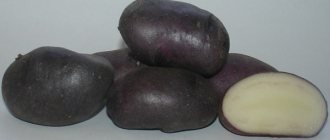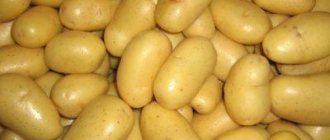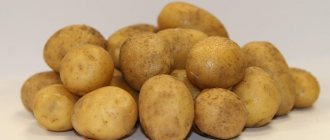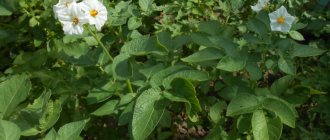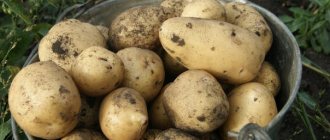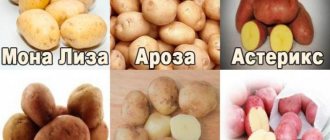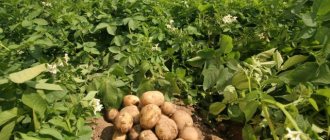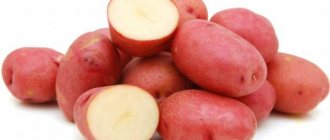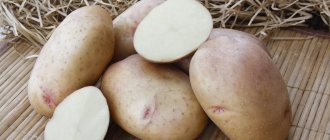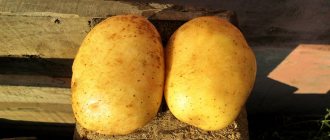The early-ripening variety Impala is of high value both for amateur gardeners and for owners of large farms involved in growing potatoes on a large scale. We will talk about the features, advantages, cultivation technology and measures of protection against all kinds of diseases and pests in more detail later in the article.
History of the variety
The history of the origin of the Impala variety began in the Dutch administrative center called Emmelord. Employees of the international company Agrico, which since 1973 has been widely known throughout the world for its innovative developments in the field of potato growing, obtained this potato variety through selective breeding.
In 1992, based on the results of variety trials, Impala was included in the State Register of Plants of the Russian Federation. In 2000, it was included in the State Registers of Ukraine and the Republic of Belarus. In the Russian Federation, the cultivation of the Impala potato variety is limited to four regions, such as:
- Volgo-Vyatka (Kirov, Nizhny Novgorod and Sverdlovsk regions; Republic of Mari El; Perm Territory; Udmurt and Chuvash Republics).
- Nizhnevolzhsky (Astrakhan, Saratov and Volgograd regions; Republic of Kalmykia).
- Northwestern (Vologda, Kaliningrad, Kostroma, Leningrad, Novgorod, Pskov, Tver and Yaroslavl regions).
- Central (Bryansk, Vladimir, Ivanovo, Kaluga, Moscow, Ryazan, Smolensk and Tula regions).
However, despite this, the Impala variety has become widespread throughout the Russian Federation. In some regions of the Russian Federation and Ukraine they gave it simpler and more familiar names - Kubanka or Krymchanka.
Fertilizing
Fertilizers are applied to Impala potatoes at least three times during the season. Before the first hilling procedure, 10 g of ammonium nitrate and 150 g of humus should be added to each bush. Instead of this fertilizer, you can pour in a solution of bird droppings diluted with water in a ratio of 1:20 or slurry.
Potato variety Impala - photo
Before flowering begins, a couple of handfuls of ash or 10 g of potassium salt are added under each bush. After flowering has ended, a solution containing 35-40 g of superphosphate and 1.5 cups of mullein, diluted in a bucket of water, is applied under the bushes.
Description of the Impala potato
Bushes. The height of the potato bush reaches 75-80 cm. The plants are erect, with 4-5 well-leafed stems on each bush. The leaves are medium in size, quite dense and colored a rich green color. A slight waviness can be observed along the edge of the leaf. The flowers grow white with a small yellow center.
Roots. As a rule, about 15 tubers are formed on each bush. The root crops are large, oval and sometimes round-oval in shape. The bulk of the tubers gain until August. Their average weight is 90-160 grams. The peel is yellowish in color, characterized by smoothness and ease of cleaning due to its loose structure. The number of ocelli is moderate. They are very small and lie shallow on the surface of the peel. The pulp is light yellow, creamy.
Characteristics and features of the variety
Let's consider the features and main characteristics of the Impala potato variety according to the following criteria:
- Rate of maturation. This is an early ripening potato variety. The first harvest will be available for harvest 45 days after planting. Depending on the climate zone, full ripening occurs in 60-70 days.
- Resistance to adverse weather conditions. The Impala variety tolerates both dry weather and high humidity conditions. Due to this property, it is widely distributed in various regions.
- Resistance to mechanical damage. The high resistance of root crops to mechanical damage allows them to completely preserve their original appearance after harvesting.
- Demanding requirements for soil. Potatoes of this variety are characterized by unpretentiousness to the type of soil, however, as practice shows, better results can be achieved when grown in unprotected soil.
- Keeping quality. Suitable for both consumption and storage for a long period of time. During long-term storage, it retains its properties and presentation well.
- Disease resistance. Impala is resistant to most viruses and diseases that often affect other potato varieties. This property is due to the fact that early ripening makes it possible to avoid many potato diseases that actively develop with the arrival of autumn. The table shows the main diseases and the degree of resistance of this variety to them :
| High stability | Medium stability | Low stability |
| Golden potato nematode | Common scab | Rhizoctoniosis |
| Potato cancer | Late blight of tubers and tops | Powdery scab |
| Viruses A and Yn |
Agricultural technology
In the case of early ripening potato varieties, proper preparation of seeds for planting and compliance with all standards play a very important role. For a good harvest, it is better to give preference to large seed tubers. The more living eyes on a potato, the greater the chance that you will end up with a large and lush bush with many root vegetables.
For high-quality forcing, we recommend selecting only healthy tubers of the presented variety. As for the cuts, they are not suitable for early planting. You should only take whole potatoes. The Impala variety is different in that it can be planted without preheating the seed.
If you want to get the earliest harvest already on day 40-45, we recommend preparing seedlings in advance. It is germinated in a well-lit room at a temperature of 12°C to 15°C for 25-30 days. Growing seedlings should begin in mid-March so that the prepared material can be planted by the end of April.
Ready seedlings can be planted with or without the mother tuber. In the latter option, the seedlings are divided into separate stems and planted separately. The remaining mother tuber can also be planted. Water the seedlings as needed, taking into account the nature of the soil and weather conditions.
For a good harvest, it is advisable to choose light soils on which legumes, corn and cruciferous vegetables previously grew.
Early varieties, including Impala, love mineral and organic fertilizers. This is an additional source of heat and power. Applying manure improves the soil structure. Nitrogen fertilizers must be accurately dosed and applied before planting the site. It is recommended to add phosphorus and potassium in the fall.
The exact dosages are indicated in the description of these drugs on the packages and depend on the form of release and concentration. The Impala variety should be planted in high ridges with sharp tops. This will provide the plant with additional warmth.
As mentioned earlier, planting is carried out in the last ten days of April, with earlier planting possible. It is not recommended to plant early potato varieties later. The width between rows should be 60 centimeters.
The distance between bushes in a row is 25-30 centimeters. Tubers are planted at a depth of 6-8 centimeters. To protect the shoots from night frosts, you can sprinkle the young stems with loose soil.
It warms the soil well and requires abundant pre-watering. Further care for this potato variety includes weed control, fluffing up the rows and moderate watering.
plodovie.ru
Productivity and taste
Impala potatoes have not only high, but also stable yields. Farmers harvest from 180 to 360 centners of root crops per hectare of land per season. Amateur gardeners get a harvest from one bush - at least 0.5 kg with early ripening, and from 1 to 2 kg of already ripened potatoes.
In the southern regions, it is possible to ripen two harvests per year. For this purpose, the bushes are carefully removed from the soil, the tubers are removed, the hole is watered abundantly, and the bush with the remaining small tubers is planted back into it. The main condition is to perform these actions in cloudy weather.
The variety is intended for table use and has a rather low starch content (10-14%). After heat treatment, the potatoes become moderately soft, but do not become overcooked or darken. In this regard, it is perfect for consumption in any form (boiled, baked, fried). Due to their excellent tasting properties, Impala potatoes can be used for preparing both first and second courses, as well as for salads.
Potato care
The early Impala variety produces excellent harvests if it is well cared for. Although the plant is unpretentious, it requires timely feeding and watering.
To form large tubers, it is necessary to hill up the bushes; this also helps the tops not to fall apart.
The first time the procedure is performed when the height of the shoots reaches 12-15 cm. The earth is raked to the base of the stems with a hoe, forming a cone. I re-hill the crop before flowering. This is easiest to do after rain or watering.
Watering
The yield of crops depends on soil moisture. If the summer is too dry and watering rules are not followed, the tubers form poorly and grow small and crooked. Their taste also suffers greatly.
The ripening period of potatoes is significantly reduced if you start abundant watering during the formation of flowers on the tops of the flowers. Until this moment, the plant is not watered.
After the formation of buds and until harvesting, the soil should be kept moist and loosened after each watering. The crust that forms on the soil surface after water evaporates interferes with natural soil ventilation and disrupts the development of tubers.
Water the crop in the evening or in cloudy weather. Some summer residents practice irrigating irrigation using sprayers. With this type of watering, much less water is wasted, but moisture that gets on the tops can cause late blight.
Fertilizer
With the help of proper feeding, you can not only increase productivity, but also slightly speed up the ripening process. To ensure that the plant can form large and even tubers, it is recommended to feed it.
If fertilizers were not applied in autumn and spring or green manure was sown, then fertilizing during the growing season is simply necessary. Before flowering, the bushes are watered with an infusion of mullein or bird droppings. To do this, fresh feces are soaked in a container in a ratio of 1:5 with water.
After 2 weeks, 0.5 liters of the slurry are dissolved in a bucket of water and poured strictly under the root. You can also add wood ash to the soil when hilling.
In the fall, when digging the earth, superphosphate and potassium sulfate are added at a rate of 1 kg per hundred square meters. In the spring, urea and ammonium nitrate are sealed in the same way. The main thing is to maintain concentration and not to overdo it with feeding. A lack of potassium fertilizers provokes the development of leaf bronzing, a disease that affects the tops and affects the growth of the entire plant.
Advantages and disadvantages of the variety
The main undeniable advantages of Impala potatoes include:
- precocity;
- consistently high productivity;
- drought and moisture resistance;
- high transportability and keeping quality;
- resistance to mechanical damage;
- excellent taste of root vegetables;
- unpretentiousness to planting soil;
- versatility in cooking and cooking methods;
- attractive presentation;
- compact arrangement of tubers on bushes, which allows you to quickly and with minimal effort collect root crops;
- high resistance to major diseases.
Among the disadvantages of the variety, we note the following:
- susceptible to damage from the Colorado potato beetle, and therefore requires additional treatment against pests;
- seeds are not available for sale in all regions;
- It is necessary to carry out preventive measures aimed at protecting against fungal diseases.
Features of planting and growing Impala potatoes
In order to obtain the highest possible results from growing this variety, you should familiarize yourself with the necessary agrotechnical measures.
Optimal timing and location selection
Experts recommend planting potatoes in late April - early May. During this period, the soil already has time to warm up to the required temperature, and the humidity is still maintained at a sufficient level. Planting should be done after the end of return frosts. To get two harvests per season, in the southern regions of the Russian Federation, the Impala variety begins to be planted in late February - early March under spunbond.
The key rule in potato cultivation is compliance with crop rotation.
Areas where winter crops, legumes and perennial grasses previously grew are considered favorable for planting. Planting after crops belonging to the nightshade family (for example, tomatoes, peppers, eggplants) is unacceptable. It is also strictly forbidden to grow potatoes in one place for several years in a row. It is recommended to grow in light to medium soils that are not too waterlogged.
Preparing the site for planting
For planting the Impala variety, as for any other, it is very important that the soil is fertile and loose. To get an optimal harvest, you should enrich the soil with nutrients.
Impala responds well to mineral fertilizers. It would not be a bad idea to add a moderate amount of nitrogen to the soil in the fall, and in the spring, when planting tubers, you should add wood ash as a good tuber antiseptic and potassium fertilizer.
Tuber preparation
It is recommended to start germination in the second decade of March. Tubers of medium size (up to 5 cm) and weighing 50-80 g, on which there are many eyes, are used as seed material. Tubers of larger diameter should be divided so that each half retains some of the pulp and a stocky sprout.
A prerequisite is the selection of only healthy tubers, without rot, deformation and signs of any diseases. In order to increase the number of eyes, it is recommended to perform ringing - a transverse cut is made in a circle at the top of the tuber.
The seed potatoes are then placed in a bright place in a box for further germination. For the first few days, the temperature in the room must be maintained at +18...+25 °C, then it is reduced to a level of +12...+15 °C and maintained on an ongoing basis for another 30 days. Additionally, the level of illumination is also increased. Once every few days, potato tubers must be sprayed with water to maintain high humidity.
It is not necessary to pre-heat and germinate the planting material, but in this case the period of its maturation increases.
Seed potatoes that have not sprouted or have rotted should be monitored and discarded.
To prevent the occurrence of possible diseases and, as a result, ensure a higher yield, seed material should be treated with available means such as potassium permanganate, boric acid or wood ash. When the tubers completely germinate, they are placed in a special solution for 30-40 minutes. After this, the seed tubers must be ventilated.
Options for preparing a solution for 10 liters of water can be as follows:
- 1 g potassium permanganate;
- 10 g each of copper sulfate and zinc sulfate;
- 50 g boric acid.
The solution must not be prepared in metal containers.
Chemical treatment is also widely used, but it must be taken into account that it has a rather harmful effect on the resulting crop.
Another simple and inexpensive method of disinfecting and enriching tubers with nutrients is dusting them with wood ash. To do this, before planting, place 2 tablespoons of wood ash in each dug hole.
Planting in the ground, planting pattern and depth
When planting tubers, you should adhere to the following basic rules:
- The depth of the hole is no more than 6-8 cm.
- 200 g of wood ash is added to each hole.
- The tubers are placed with the sprouts facing up.
- The height of the soil ridge raised above the tubers should be 8-10 cm.
- It is preferable to place the furrows from north to south, so that a sufficient amount of sunlight will reach the bed. This helps to increase the overall yield, as well as an increase in the content of the mass fraction of starch in potatoes.
An approximate scheme for planting seed potatoes is shown below:
In soil heated to +22...+25°C, the first shoots will appear within two weeks. At higher soil temperatures, crop growth slows down.
After the first shoots have appeared, the planted potatoes should be hilled up and fertilized.
Fertilizer application
To obtain maximum yield, it is very important to feed the soil. Taking into account many years of experience, a mixture of 700 g of humus with 5 tablespoons of wood ash has worked well. It is placed in each hole. Among mineral fertilizers, it is necessary to note such as potato kemira (20 g) and nitrophoska (1 tbsp. l.). To avoid damage to potato tubers, fertilizers should be applied only after watering.
Care
The main requirements are watering, weeding, loosening and hilling.
In dry conditions, watering is carried out three times per season (a month after planting, during flowering and 14 days after it). The average water consumption should be 40 liters per 1 sq. m.
Loosening the soil and weeding the rows is carried out simultaneously after each watering or precipitation.
Hilling is carried out when the bushes reach a height of 20 cm, which helps strengthen the root system.
Correct implementation of these agrotechnical measures allows you to increase productivity by a quarter.
Requirements for planting material
For planting Impala, seed material that complies with GOST R 53136–2008 is recommended. The timing of planting potatoes varies, but in the Central Federal District it is best to plant it at the end of April or the first ten days of May, when the soil is warm enough and the moisture necessary for germination is maintained.
For planting, areas that were previously used for growing legumes, winter crops and perennial grasses are preferred.
The key to obtaining a good harvest is the correct and timely preparation of seed material in the spring.
For the first few days, the temperature required for high-quality germination should be +18...+25 °C, and then, until planting, the temperature should be reduced to +12...+14 °C, and the illumination of the tubers should also be increased.
To increase the number of eyes on a potato tuber, ringing should be done, i.e. make a transverse circular cut closer to the top of the tuber.
Treatment of seed material before planting with strong chemicals has become very popular in recent years and is regarded by many as a guarantee of a high-quality, disease-resistant harvest. However, a positive result can be achieved by using less harmful agents, such as potassium permanganate, wood ash and boric acid.
It is recommended to immerse a box with fully germinated seed tubers in a solution of potassium permanganate (the solution is prepared at the rate of 1 g of potassium permanganate per bucket of water) and leave it in it for 30–40 minutes, and then dust the tubers with wood ash.
A good result is obtained by adding ash to each planting hole during the spring planting of potatoes. Planting rows located in the north-south, north-west or south-east directions receive more uniform sunlight, which helps to increase the overall yield, as well as increase the starchiness of potato tubers.
Protection from diseases and pests
To reduce the risk of potato damage by characteristic diseases and pest invasion to a minimum, it is necessary to take a number of preventive measures. For example, to combat late blight, treatment with Fitosporin is recommended.
To protect plants from the Colorado potato beetle and wireworm, the preparations Actellik, Corado and Aktara are used. Onion peel is also an effective folk remedy. You can get rid of the click beetle using the drug Bazudin, and from the mole cricket - Medvetox.
Read more about potato pests and methods of controlling them here.
Harvest and storage
40-60 days after the first shoots emerge, the harvest can be harvested. It is not recommended to do this before the due date, as the potatoes will have a peculiar, not entirely pleasant taste.
You can determine whether the tubers are fully ripe using the following methods:
- Count three weeks from the flowering period. This method is not entirely accurate due to possible differences in climatic conditions.
- Dig up one bush and assess the condition of the tubers.
- Pay attention to the general condition of the bush. If the lower leaves begin to turn yellow and the branches fall to the ground, you can safely begin harvesting.
After harvesting the potatoes, it is necessary to dry them in a well-ventilated, dry place. The crop should be protected from direct sunlight, this can lead to its unusability, as the root crops will turn green.
It is recommended to store potatoes in a single layer in a ventilated area. From time to time the condition of the tubers is checked. If the fruits are planned to be prepared as seeds for planting, they, on the contrary, should be placed in the sun and allowed to turn green. Compliance with these measures helps to reduce the starch content and increase the sugar and acid content.
What kind of harvest you get when planting Impala potatoes can be clearly seen in the following video:
Reviews
★★★★★
Neonila Petrovna, 52 years old. I regularly plant this variety on my own plot.
I like that the tubers grow even and beautiful. Well suited for both boiling and frying. Doesn't turn into mush. I'm very pleased. I now recommend him to all my friends. ★★★★★
Dmitry, 35 years old. Impala's early maturity and ease of care are captivating.
Thanks to the simple and inexpensive treatment of tubers using a solution of potassium permanganate, I harvest a bountiful harvest that is not affected by disease. Potatoes tolerate transportation well and do not lose their presentation after long-term storage. Since I grow it for sale, for me these qualities are the main ones when choosing a variety. ★★★★★
Ivan Nikolaevich, 63 years old. I planted the Impala variety at the dacha on the recommendation of my neighbors.
And I was right. The potatoes grow large, one after the other. It turns out very tasty when cooked and does not overcook. And, what is very important to me, it does not require specific care and ripens quickly. Hide
Add your review
The Impala potato variety has become widespread due to its excellent taste, high yield and ease of care. By following simple recommendations, you can not only get a generous harvest, but also provide yourself with planting material for the next season.
0
0
Copy link
Advantages
In order to make it easier for a gardener to decide on the choice of Impala potato variety, you need to consider all its pros and cons. Judging by the reviews, the variety is in great demand and is grown everywhere.
The undoubted advantages of Impala potatoes are:
- large tubers weighing 100-130 g, which is quite rare for early varieties;
- the skin is thin but durable - it allows the potatoes to be stored well all winter and even until the new harvest;
- each tuber has from 9 to 15 eyes, which makes it possible to divide it into parts before planting; the taste qualities are very high.
Even with scanty watering and little hilling, 5-8 tubers are formed on the bush, and if all the requirements for growing conditions have been met, the harvest will be 12-18 fairly large potatoes. The description of the tubers is typical for Dutch varieties.
